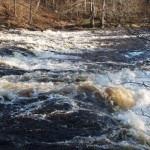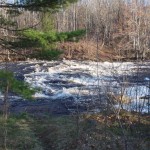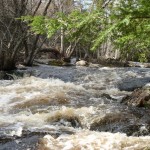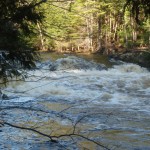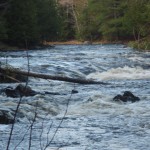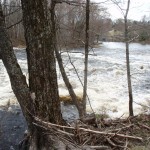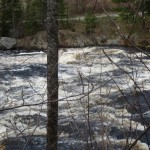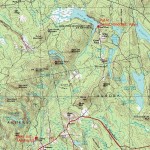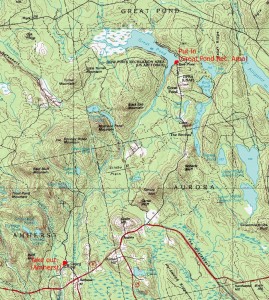
Story has it that the Union River takes its name from the fact that when the area was surveyed by Samuel Livermore in the late 1700’s, the river ran right down the middle of twelve newly formed towns.
Nowadays, the upper part of the Union is in the middle of nowhere — and that is just fine with us.
The West Branch of the Union, north of the Airline Road, is billed as Hancock County’s “finest” whitewater run. We ran it last Saturday for the first time, and it didn’t disappoint.
After a 50 mile drive from Belfast to Amherst via Bucksport and Dedham, we pulled over alongside Tannery Falls (just off the Tannery Loop) and unloaded our bicycles, which we would use later for our return to the put in. We took a close look at the falls, which though rated “only” a Class III looked fairly gnarly. Would we run the falls or take out above them? We reserved that decision for later. According to the Zip Kellogg’s canoeing guide, if exposed dry rock is visible at Tannery Falls, the river is too low to run. If the falls have the appearance of a raging river, it advises, “Don’t try to paddle the river.” The level looked closer to raging than to dry, but “raging” — we decided — is somewhat a matter of perspective.
We drove 12 miles north to Great Pond via Aurora and the Great Pond Road. After passing through the tiny village of Great Pond, the road turns steeply downhill to the Great Pond Recreation area (formerly Dow Pines), a military-owned campground (open year year; includes cabins and yurts as well as tent sites) that allows public use of their beach and boat launch. The 375-acre recreation area borders the entire southern edge of Great Pond and also extends south along the western shore of the Union River.
We launched our kayaks from the sandy beach and headed south through a bay that gradually narrows to the mouth of the river. Great Pond is largely wild and undeveloped. Kellogg comments that it is particularly beautiful in the fall, as the the pond is in the center of a bowl of hills and the surrounding slopes have plenty of hardwoods.
Although some sections of the river are not far from roads, The West Branch of the Union provides a sense of wilderness and seclusion. We sighted no other paddlers, and only a few fishermen during our 11 mile river journey. The area is rife with wildlife, however. Hundreds of ducks as well as hawks, deer, turtles, blue heron, cormorants, beaver, and wild turkeys were among the wildlife we encountered.
The paddling was outstanding. The river is larger and has stronger currents than most of our midcoast rivers. That plus the seclusion and our unfamiliarity with the river made us a bit conservative. The river has sections of flatwater, frequent stretches of rips and easy rapids, and a few stretches of challenging whitewater (strong currents and decent sized waves). Most notable are the drops. The West Branch has multiple small pitches of a few feet in height. It also has four larger ones, with names like “Hell Gate” and “Captains Roll.” Kellogg recommends scouting these drops and we emphatically concur.
The importance of scouting was reinforced by our experience at one of the earlier, easier drops. Without scouting it beforehand, we lined up to take the drop at Bog Dam rapids “right of center,” just as the guidebook suggested. However, immediately after taking the drop, I was spun and nearly capsized by a mossy green sleeper rock. Leslie, who had been following close behind, backpaddled to avoid my boat, never saw the rock, had her kayak pushed far up onto it, and was spun before finally capsizing. (See all the action in the video below).
Partly due to the time factor (it often takes longer to scout and then go back upriver and run a rapid than to simply portage it), we opted for short portages around the three major drops and took out above the fourth. This was a recon mission — and for that day at least, just being in the vicinity of those falls provided plenty of adrenalin.
Those pitches are not easy to get out of your head. I’ve been seeing Hell Gate in my dreams and am itching to head back up there and give it a try.

